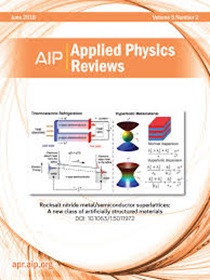Incubating advances in integrated photonics with emerging sensing and computational capabilities
IF 11.9
1区 物理与天体物理
Q1 PHYSICS, APPLIED
引用次数: 0
Abstract
As photonic technologies grow in multidimensional aspects, integrated photonics holds a unique position and continuously presents enormous possibilities for research communities. Applications include data centers, environmental monitoring, medical diagnosis, and highly compact communication components, with further possibilities continuously growing. Herein, we review state-of-the-art integrated photonic on-chip sensors that operate in the visible to mid-infrared wavelength region on various material platforms. Among the different materials, architectures, and technologies leading the way for on-chip sensors, we discuss the optical sensing principles that are commonly applied to biochemical and gas sensing. Our focus is on passive optical waveguides, including dispersion-engineered metamaterial-based structures, which are essential for enhancing the interaction between light and analytes in chip-scale sensors. We harness a diverse array of cutting-edge sensing technologies, heralding a revolutionary on-chip sensing paradigm. Our arsenal includes refractive-index-based sensing, plasmonics, and spectroscopy, which forge an unparalleled foundation for innovation and precision. Furthermore, we include a brief discussion of recent trends and computational concepts, incorporating Artificial Intelligence & Machine Learning (AI/ML) and deep learning approaches over the past few years to improve the qualitative and quantitative analysis of sensor measurements.孵化集成光子学与新兴传感和计算能力的进展
随着光子技术在多维方面的发展,集成光子学占据了独特的地位,并不断为研究领域提供巨大的可能性。应用程序包括数据中心、环境监测、医疗诊断和高度紧凑的通信组件,而且可能性还在不断增加。在此,我们回顾了最先进的集成光子片上传感器,这些传感器在可见光到中红外波长范围内工作在各种材料平台上。在片上传感器的不同材料、结构和技术中,我们讨论了通常应用于生化和气体传感的光学传感原理。我们的重点是无源光波导,包括基于色散工程的超材料结构,这对于增强芯片级传感器中光和分析物之间的相互作用至关重要。我们利用各种尖端传感技术,预示着革命性的片上传感范式。我们的武器库包括基于折射率的传感,等离子体和光谱学,为创新和精度奠定了无与伦比的基础。此外,我们还简要讨论了最近的趋势和计算概念,包括人工智能和;机器学习(AI/ML)和深度学习方法在过去几年中改进了传感器测量的定性和定量分析。
本文章由计算机程序翻译,如有差异,请以英文原文为准。
求助全文
约1分钟内获得全文
求助全文
来源期刊

Applied physics reviews
PHYSICS, APPLIED-
CiteScore
22.50
自引率
2.00%
发文量
113
审稿时长
2 months
期刊介绍:
Applied Physics Reviews (APR) is a journal featuring articles on critical topics in experimental or theoretical research in applied physics and applications of physics to other scientific and engineering branches. The publication includes two main types of articles:
Original Research: These articles report on high-quality, novel research studies that are of significant interest to the applied physics community.
Reviews: Review articles in APR can either be authoritative and comprehensive assessments of established areas of applied physics or short, timely reviews of recent advances in established fields or emerging areas of applied physics.
 求助内容:
求助内容: 应助结果提醒方式:
应助结果提醒方式:


